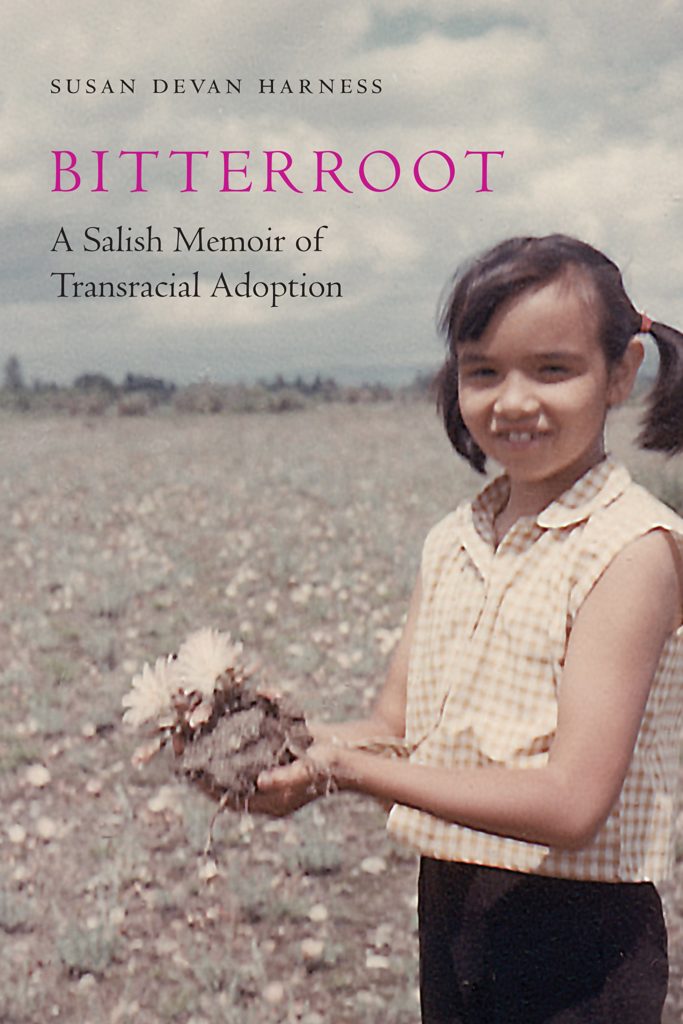Reviewed by Victoria Collins
 “The Indians don’t want me. The whites don’t accept me. They push me into each other’s court, always away from them. I am isolated; I am in-between.”
“The Indians don’t want me. The whites don’t accept me. They push me into each other’s court, always away from them. I am isolated; I am in-between.”
Susan Harness’ Bitterroot: A Salish Memoir of Transracial Adoption (University of Nebraska Press, Oct 2018) is a poignant personal journey of coming to terms with identity and history. It’s thorough in its observations and biting in its critiques of American policy that dictated the handling of Native American populations amidst an era of westward expansion.
The title of the memoir, Bitterroot, is an homage to Harness’ roots as someone who grew up in the state of Montana which takes the bitterroot flower as its state flower.
The book is a testament to the dissonance one feels when living on the fringes of American society. Harness, a member of the Confederated Salish Kootenai Tribes and an American Indian, was adopted into a white home outside of her tribal reservation, severing all connection to her familial and cultural roots. Throughout this honest retelling of a quest to find identity, Harness parlays her experience and feelings as a “transracial adoptee” and American Indian into a triumphant story about reckoning with identity and uncovering the systemic roots that have produced the cultural dissonance within her.
Bitterroot is a beautiful telling of Harness’ anxiety over trying to exist in two very different world simultaneously—white America and Harness’ internal conflict finds its roots in her anxieties of living in white America. She writes, “Because white Americans have been systemically and politically exempt from the ramifications of specific moments in history and its consequences have no meaning.” There are moments in Native American history that are so traumatic and have such lasting consequences that the present generation still carries the weight of those traumas.
Harness’ crisis of identity is more broadly linked to the traumatic heritage of Native Americans throughout U.S. history. Indian Removal and the beginning of reservations were crucial points in history because it was the government sanctioned uprooting of entire cultures and ways of life. “Land is so closely associated with the people, the culture, that sit on its soil.”
Harness weaves in historical information about pivotal legislation enacted towards the end of the 19th century. One such group of legislation was the Dawes Acts, particularly the formation of the Dawes Rolls in 1893. The U.S. attempts to codify the merits of Indian-ness by pitting the civilized against the uncivilized and ultimately, changes the trajectory of Native American culture from that moment forward.
But Harness’ search for her birth family brings about another crisis of familial identity. When she finally does track down her birth family to a reservation only 40 miles from where she’d grown up, she writes, “Blood is thicker than water, but thinner than time.” After searching so long for her biological family, it dawns on her that these people know nothing about her. Thirty years of separation had reduced her and her siblings to strangers despite their blood relation.
Harness’ adoption into a white family outside of Flathead Indian Reservation in western Montana where she was born resulted in a similar crisis of cultural identity. As she grew old enough to ask questions about her “real” family, she takes it upon herself to find her own answers. An academic in the field of cultural anthropology, Harness not only relays her own experience as a transracial adoptee, she also catalogs the experience of other Natives who were also adopted into white families across the Midwest who experienced similar longings for identity and heritage.
When one thinks of adoption, there is the hope that the child’s situation will improve with placement into a functioning family unit. However, this is not the case with Harness’ family. Her adopted father drank heavily while her adopted mother battled with mental illness. She endured slurs, stereotypes, and stigmas that her adopted family constantly threw her way. Though she was proud of her Indian heritage, she was acutely aware that “Indian” did not have a positive connotation in white America. Conversely, Harness is not accepted by her Indian family, either. Years of living among white people had robbed her of her perceived “Indianness.”
Sue says of her adopted father, “I think he believed if he could raise me just right, I wouldn’t be Indian anymore. If I was white I would be free from prejudices, free from the hatred so entrenched in Montana culture. But in the American West, being Indian is what you are, not what you choose to be, especially if you look like one.”
The book speaks to the universality in experience of searching for identity in white America. This book is recommended reading for its examination of American history in relation to its treatment of the Native Americans, its unapologetic portrayal of growing up “other” in white Americans.
Though there is a distinct sense of dissonance throughout the book, Sue still locates pride in her heritage, when all is said and done. And in finding pride in a troubled history, she is more able to combat her own internal conflict. Despite feelings of abandonment and nonbelonging, love and understanding can still prevail.
 Victoria is a creative writing MFA student at The New School. Their curiosities and passions have brought them to NYC all the way from Hattiesburg, Mississippi. Their writing focuses on their reflections on growing up in the South and issues of race, gender, and sexuality.
Victoria is a creative writing MFA student at The New School. Their curiosities and passions have brought them to NYC all the way from Hattiesburg, Mississippi. Their writing focuses on their reflections on growing up in the South and issues of race, gender, and sexuality.



1 comment for “Review: Bitterroot: A Salish Memoir of Transracial Adoption (American Indian Lives) by Susan Devan Harness”